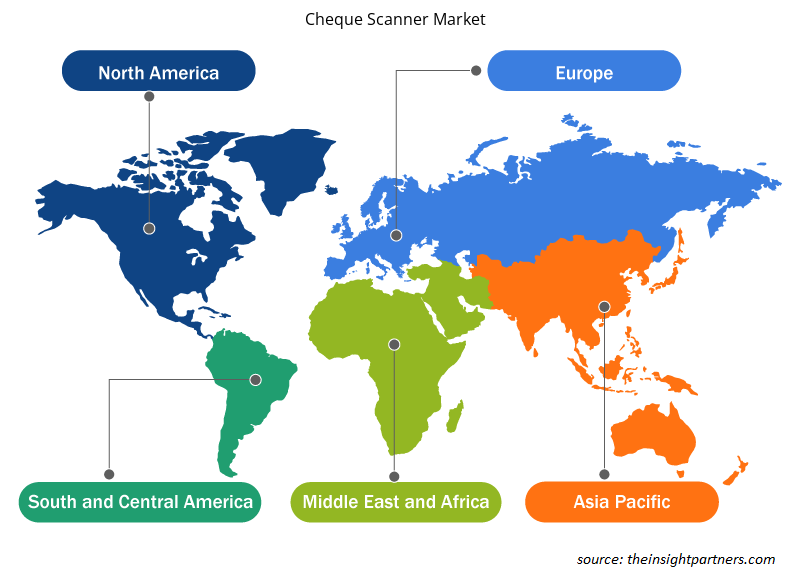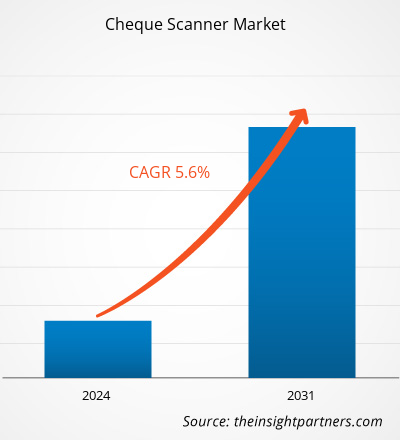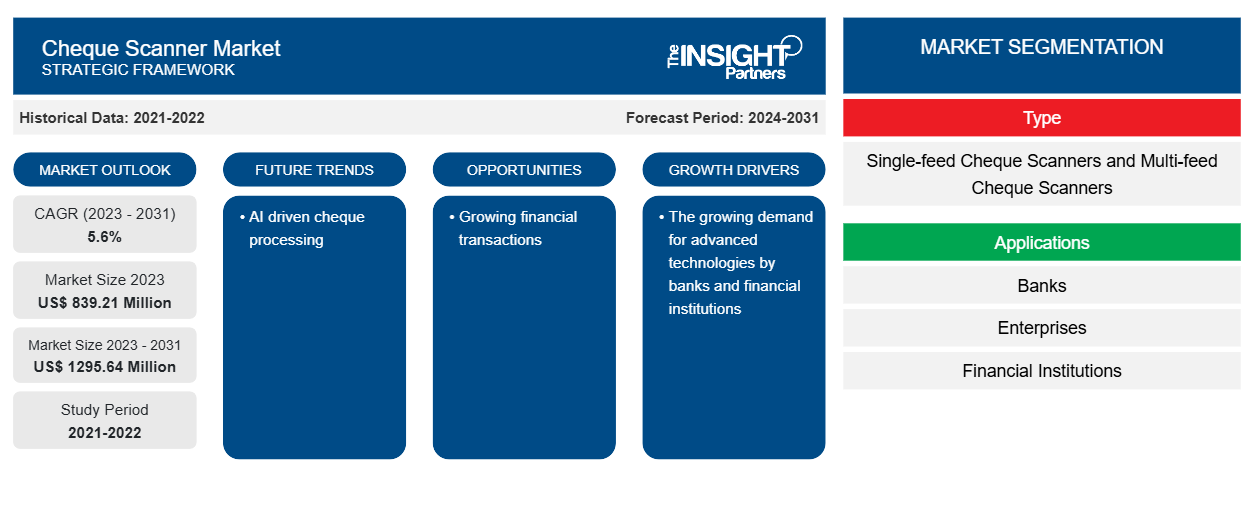Si prevede che il mercato degli scanner per assegni raggiungerà 1295,64 milioni di dollari entro il 2031, rispetto agli 839,21 milioni di dollari del 2023. Si prevede che il mercato registrerà un CAGR del 5,6% nel periodo 2023-2031. La crescente domanda di tecnologie avanzate da parte di banche e istituzioni finanziarie e la necessità di risparmiare tempo operativo nelle banche rimarranno probabilmente tendenze chiave nel mercato.cheque scanner market is projected to reach US$ 1295.64 million by 2031 from US$ 839.21 million in 2023. The market is expected to register a CAGR of 5.6% during 2023–2031. The growing demand for advanced technologies by banks and financial institutions and the need to save operating time in banks are likely to remain key trends in the market.
Analisi di mercato degli scanner per assegni Scanner Market Analysis
I vantaggi dell'utilizzo di scanner per assegni, come il risparmio sui costi amministrativi e di manodopera, il deposito remoto degli assegni, l'accesso rapido ai dati, l'aumento della sicurezza e la produttività migliorata, stanno alimentando la domanda di scanner per assegni in banche, aziende e istituti finanziari. La crescente inclinazione verso la cattura remota dei depositi (RDC) sta guidando il mercato degli scanner per assegni.
Panoramica del mercato degli scanner per assegni
Uno scanner per assegni è un dispositivo elettronico che utilizza la tecnologia di riconoscimento dei caratteri a inchiostro magnetico (MICR) per scansionare e leggere gli assegni. Gli scanner per assegni sono sviluppati per migliorare l'efficienza dell'elaborazione degli assegni. Lo scanner per assegni aiuta a risparmiare tempo e denaro. Questi scanner catturano il fronte e il retro dell'assegno e ne registrano le informazioni, come il conto bancario, la firma, l'importo dell'assegno e altro. Con la necessità di migliorare l'efficienza nel flusso di lavoro e nelle operazioni aziendali, la domanda di scanner per assegni è in crescita.
Personalizza questo report in base alle tue esigenze
Riceverai la personalizzazione gratuita di qualsiasi report, comprese parti di questo report, o analisi a livello nazionale, pacchetto dati Excel, oltre a usufruire di grandi offerte e sconti per start-up e università
-
Scopri le principali tendenze di mercato in questo rapporto.Questo campione GRATUITO includerà analisi di dati che spaziano dalle tendenze di mercato alle stime e alle previsioni.
Driver e opportunità del mercato degli scanner per assegni
Le banche puntano sulla soddisfazione del cliente
Le banche sono molto concentrate sulla soddisfazione del cliente per mantenere i clienti esistenti e attrarne di nuovi. Per questo, adottano dispositivi intelligenti e tecnologicamente avanzati che velocizzano le operazioni bancarie e il flusso di lavoro, il che porta alla richiesta di scanner per assegni. Gli scanner per assegni nelle banche le aiutano a potenziare le operazioni di elaborazione degli assegni. Lo scanner può registrare le informazioni dell'assegno, il che aiuta la banca a mantenere i propri registri.
Crescita delle transazioni finanziarie
Con l'aumento della popolazione e delle attività commerciali in crescita, le transazioni finanziarie stanno aumentando. Con questo, c'è bisogno di tecnologie di scansione degli assegni efficienti e accurate per gestire il crescente volume di assegni, il che porta alla domanda di scanner per assegni. Questi scanner riducono il rischio di errori durante l'elaborazione degli assegni. Aiutano anche a ridurre gli errori umani. È una soluzione ideale per ambienti di acquisizione di depositi ad alto volume.cheque scanning technologies to handle the growing volume of cheques, which leads to the demand for cheque scanners. These scanners reduce the risk of errors when processing cheques. It also helps to reduce the human errors. It is an ideal solution for high-volume deposit capture environments.
Analisi della segmentazione del rapporto di mercato degli scanner per assegni Scanner Market Report Segmentation Analysis
I segmenti chiave che hanno contribuito alla derivazione dell'analisi di mercato degli scanner per assegni sono la tipologia e l'applicazione.cheque scanner market analysis are the type and application.
- In base al tipo, il mercato degli scanner per assegni è suddiviso in scanner per assegni a caricamento singolo e scanner per assegni a caricamento multiplo. Si prevede che il segmento degli scanner per assegni a caricamento multiplo crescerà con il CAGR più elevato.cheque scanner market is divided into single-feed cheque scanners and multi-feed cheque scanners. The multi-feed cheque scanners segment is expected to grow with the highest CAGR.
- Per applicazione, il mercato è segmentato in banche, imprese e istituzioni finanziarie. Il segmento bancario deteneva la quota maggiore del mercato nel 2023.
Analisi della quota di mercato degli scanner per assegni per area geografica Scanner Market Share Analysis by Geography
L'ambito geografico del rapporto sul mercato degli scanner per assegni è suddiviso principalmente in cinque regioni: Nord America, Asia Pacifico, Europa, Medio Oriente e Africa, e Sud e Centro America.cheque scanner market report is mainly divided into five regions: North America, Asia Pacific, Europe, Middle East & Africa, and South & Central America.
Si prevede che la regione Asia-Pacifico crescerà con il CAGR più elevato. I vantaggi degli scanner per assegni per accelerare l'elaborazione degli assegni hanno portato alla sua adozione da parte di diverse banche e istituzioni finanziarie . Queste banche e istituzioni finanziarie sono focalizzate sulla riduzione al minimo delle frodi, il che porta all'adozione di soluzioni tecnologicamente avanzate come gli scanner per assegni.CAGR. The benefits of check scanners to speed up cheque processing led to its adoption among several banks and cheque scanners.
Approfondimenti regionali sul mercato degli scanner per assegni Scanner Market Regional Insights
Le tendenze regionali e i fattori che influenzano il mercato degli scanner per assegni durante il periodo di previsione sono stati ampiamente spiegati dagli analisti di Insight Partners. Questa sezione discute anche i segmenti e la geografia del mercato degli scanner per assegni in Nord America, Europa, Asia Pacifico, Medio Oriente e Africa e Sud e Centro America.Cheque Scanner Market throughout the forecast period have been thoroughly explained by the analysts at Insight Partners. This section also discusses Cheque Scanner Market segments and geography across North America, Europe, Asia Pacific, Middle East and Africa, and South and Central America.

- Ottieni i dati specifici regionali per il mercato degli scanner per assegniCheque Scanner Market
Ambito del rapporto di mercato sugli scanner per assegni
| Attributo del report | Dettagli |
|---|---|
| Dimensioni del mercato nel 2023 | 839,21 milioni di dollari USA |
| Dimensioni del mercato entro il 2031 | 1295,64 milioni di dollari USA |
| CAGR globale (2023-2031) | 5,6% |
| Dati storici | 2021-2022 |
| Periodo di previsione | 2024-2031 |
| Segmenti coperti |
Per tipo
|
| Regioni e Paesi coperti |
America del Nord
|
| Leader di mercato e profili aziendali chiave |
|
Densità dei player del mercato degli scanner per assegni: comprendere il suo impatto sulle dinamiche aziendali
Il mercato degli scanner per assegni sta crescendo rapidamente, spinto dalla crescente domanda degli utenti finali dovuta a fattori quali l'evoluzione delle preferenze dei consumatori, i progressi tecnologici e una maggiore consapevolezza dei vantaggi del prodotto. Con l'aumento della domanda, le aziende stanno ampliando le loro offerte, innovando per soddisfare le esigenze dei consumatori e capitalizzando sulle tendenze emergenti, il che alimenta ulteriormente la crescita del mercato.
La densità degli operatori di mercato si riferisce alla distribuzione di aziende o società che operano in un particolare mercato o settore. Indica quanti concorrenti (operatori di mercato) sono presenti in un dato spazio di mercato in relazione alle sue dimensioni o al valore di mercato totale.
Le principali aziende che operano nel mercato degli scanner per assegni sono:
- PANINI SpA
- Epson Corp
- Canone
- Controllo digitale
- MagTek
- ARCA
Disclaimer : le aziende elencate sopra non sono classificate secondo un ordine particolare.

- Ottieni la panoramica dei principali attori del mercato degli scanner per assegni
Notizie di mercato e sviluppi recenti sugli scanner per assegni
Il mercato degli scanner per assegni viene valutato raccogliendo dati qualitativi e quantitativi dopo la ricerca primaria e secondaria, che include importanti pubblicazioni aziendali, dati associativi e database. Di seguito sono elencati alcuni degli sviluppi nel mercato degli scanner per assegni:
- Digital Check Corp. ha introdotto lo scanner per assegni a caricamento singolo CheXpress CX35 di nuova generazione. CheXpress CX35 è lo scanner per assegni a caricamento singolo di nuova generazione di Digital Check Corp. progettato per la cattura remota dei depositi (RDC). Il nuovo modello rappresenta una modernizzazione importante del suo predecessore, il pluripremiato modello CheXpress CX30. Aggiunge diverse nuove importanti funzionalità allo scanner per assegni a caricamento singolo più venduto di tutti i tempi. (Fonte: Digital Check Corp, comunicato stampa, ottobre 2023)
- Canon Europe ha annunciato il lancio del suo scanner per documenti imageFORMULA R30, ideale per uffici domestici e piccole aziende. Il dispositivo ha un tempo di configurazione rapido, consentendo agli utenti di collegarlo e utilizzarlo in meno di 60 secondi, ed è ideale per gli utenti di scanner che cercano produttività, praticità e facilità d'uso. (Fonte: Canon, comunicato stampa, luglio 2023)
Copertura e risultati del rapporto di mercato sugli scanner per assegni
Il rapporto "Dimensioni e previsioni del mercato degli scanner per assegni (2021-2031)" fornisce un'analisi dettagliata del mercato che copre le seguenti aree:
- Dimensioni e previsioni del mercato degli scanner per assegni a livello globale, regionale e nazionale per tutti i principali segmenti di mercato coperti dall'ambito
- Tendenze del mercato degli scanner per assegni, nonché dinamiche di mercato quali driver, restrizioni e opportunità chiave
- Analisi dettagliata delle cinque forze PEST/Porter e SWOT
- Analisi di mercato degli scanner per assegni che copre le principali tendenze del mercato, il quadro globale e regionale, i principali attori, le normative e i recenti sviluppi del mercato
- Analisi del panorama industriale e della concorrenza che copre la concentrazione del mercato, l'analisi della mappa di calore, i principali attori e gli sviluppi recenti per il mercato degli scanner per assegni
- Profili aziendali dettagliati
- Analisi storica (2 anni), anno base, previsione (7 anni) con CAGR
- Analisi PEST e SWOT
- Valore/volume delle dimensioni del mercato - Globale, Regionale, Nazionale
- Industria e panorama competitivo
- Set di dati Excel
Report recenti
Rapporti correlati
Testimonianze
Motivo dell'acquisto
- Processo decisionale informato
- Comprensione delle dinamiche di mercato
- Analisi competitiva
- Analisi dei clienti
- Previsioni di mercato
- Mitigazione del rischio
- Pianificazione strategica
- Giustificazione degli investimenti
- Identificazione dei mercati emergenti
- Miglioramento delle strategie di marketing
- Aumento dell'efficienza operativa
- Allineamento alle tendenze normative























 Ottieni un campione gratuito per - Mercato degli scanner per assegni
Ottieni un campione gratuito per - Mercato degli scanner per assegni